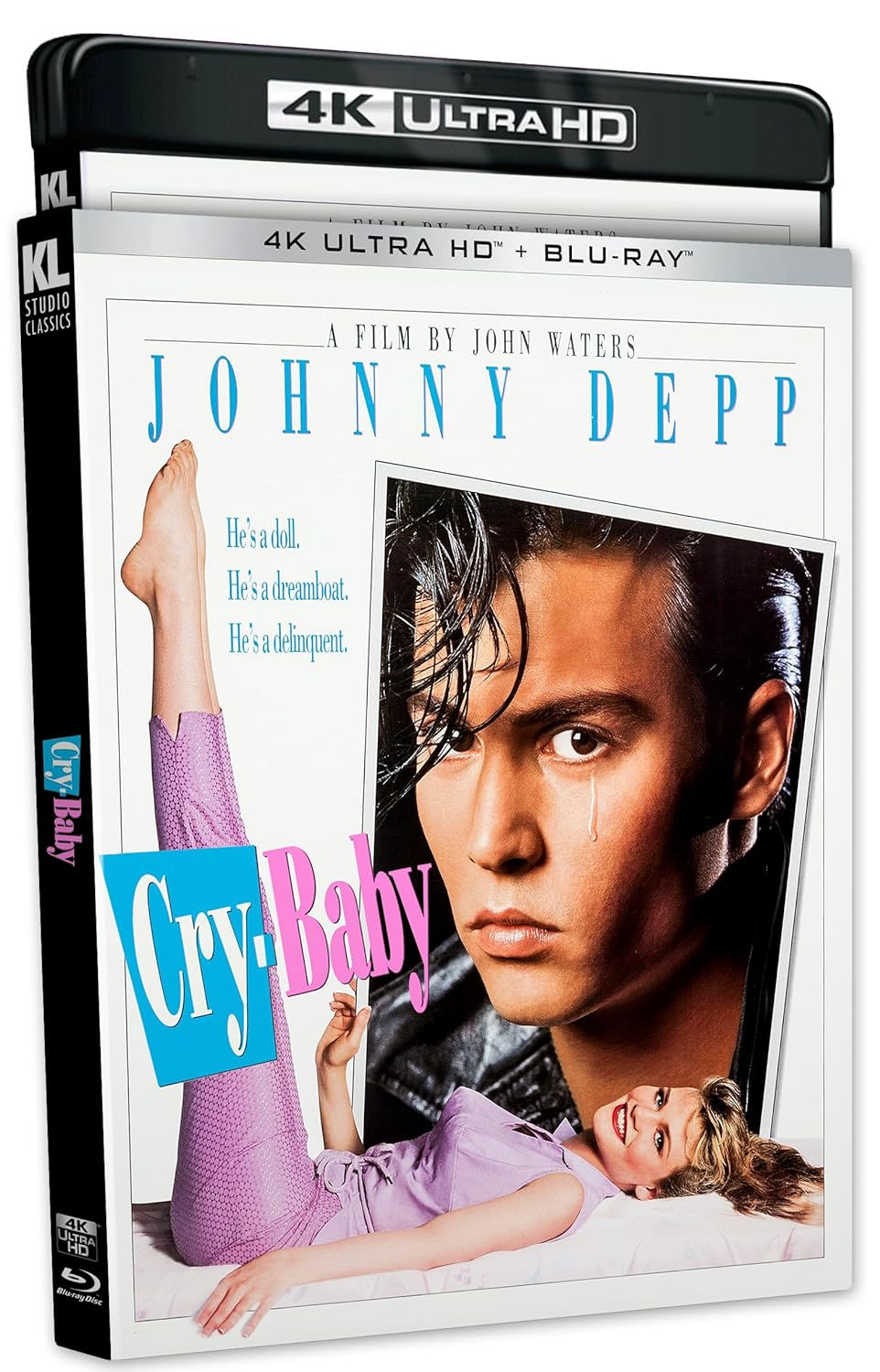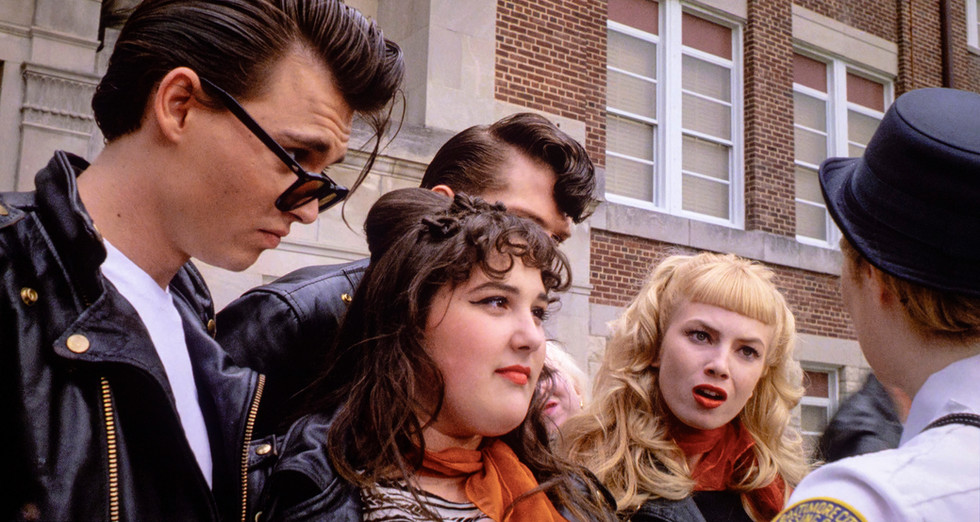Before Scissorhands, before Sparrow – Johnny Depp was “Cry-Baby”!
- Bill Kelley III
- Jul 5, 2024
- 6 min read
Updated: Jul 6, 2024
4K ULTRA HD REVIEW / HDR SCREENSHOTS
Johnny Depp stars as high school rebel and gang leader Wade “Cry Baby” Walker. Cry Baby’s family and friends: left, Sister Pepper (Ricki Lake) and her two children Susie-Q (Scout Raskin) and Snare-Drum (Jonathan Benya), Wanda Woodard (Tracie Lord), Mona “Hatchet Face” (Kim McGuire), Grandmother Ramona, Milton Hatchett (Darren E. Burrows) and Uncle Belvedere (Iggy Pop).
(Click an image to scroll the larger versions)
“CRY-BABY”
4K Ultra HD & Blu-ray; 1990; PG-13 for profanity, smoking, and sexual innuendo
Best extra: “Bringing Up Baby” featurette with new interviews
JOHNNY DEPP was heading into his late 20s and still had a baby face – making him picture-perfect to play high school rebel and gang leader Wade “Cry Baby” Walker, singer and biker, with the looks of Elvis Presley. His nickname is no accident, since he could drop a tear in the blink of an eye.
The success of writer/director John Waters’ bubblegum musical “Hairspray” (1988) starring a young Ricki Lake as teenage dancer Tracy Turnblad, paved the way for “Cry-Bay” his comical ode to ‘50s teen rebel films such as “The Wild One” (1953) with Marlon Brando, “Rebel Without a Cause” (1955) with James Dean, and “Jailhouse Rock” (1957) with Elvis.
At the time, Depp was a rising TV star on “21 Jump Street” and signed on for $1 million to play Cry Baby. His face was on the cover of every teen-magazine in the country. That was enough for Universal Studios and producer Brian Grazer – a co-partner with Ron Howard in Imagine Entertainment – to greenlight the $12 million production and advertising budget that became Waters’ first Hollywood-financed film. “I should’ve been scared, with a full crew, union Teamsters and huge cranes,” the director says during the new featurette “Bringing Up Baby.” He knew the more money you get for a project, “the more people will have a say.”
Baltimore - 1954
(1) All of the high school students receive the polio vaccine. (2&3) Cry Baby and his ‘Drape’ friends are stopped by crossing-guard Mrs. Woodard (Patricia Hearst), mother to Wanda. (4&5) Cry Baby drives his old souped car past Mrs. Vernon-Williams (Polly Bergen), with her granddaughter Allison (Amy Locane) and her ‘Square’ boyfriend Baldwin (Stephen Mailer).
Waters was known as an underground, low-budget filmmaker in Baltimore through his transgressive cult films “Pink Flamingos” (1972) and “Polyester” (1981).
He stocked “Cry-Baby” with longtime friends including casting director Pat Moran. They met in 1964 in the counter-culture section of Baltimore. “We liked movies… and had the same boyfriend,” she says. Actress Mink Stole, who plays one of the mothers in “Cry-Baby,” says they’ve worked together since Waters’ first 8mm short, “Roman Candles” (1967). “He was incredibly charismatic even then,” Stole says. “He was the most self-possessed, self-assured person I’ve ever met.”
Waters followed his script blueprint for “Cry-Baby,” “Write what you know,” and he knew the dawn of Rock ‘n’ Roll, the Doo-Wop era of his youth in 1954. “The first music you hear that your parents hate becomes the soundtrack of your life. And I never forgot it,” he says.
The racy “Cry-Baby” has similarities to the musical “Grease,” with the leather jacket greasers, here called ‘Drapes’ vs. the clean-cut ‘Squares,’ which includes Allison Vernon Williams played by 17-year-old Amy Locane. She’s the blonde who has a crush on Cry Baby and wants to go bad. Cry Baby loves her too, just like Danny Zuko and Sandy Olsson in “Grease.”
Locane’s audition was in Waters’ living room with Depp, fainting when he asked them to kiss, says Waters during his 2022 Theatrical Cut commentary. Everyone had gushing accolades for Depp. “We laughed a lot and smoked a lot,” Waters said. Both were chain-smokers then; it sounds like Waters has since given up the nasty habit.
Additional cast included former porn star Traci Lords as Wanda Woodward, proto-punk rocker Iggy Pop as Belvedere Rickettes, Polly Bergen as Allison’s grandmother, heiress Patricia Hearst plays another mother; David Nelson, son of TV parents Ozzie and Harriet, as the husband of Hearst; and Darren Burrows plays Cry Baby’s sidekick Milton Hackett, a part Brad Pitt auditioned for and didn’t get. The following year, Pitt locked his first bigtime role in Ridley Scott’s “Thelma & Louise.”
(1&2) Cry Baby and his friends including Wanda end up at his grandmother’s house. (3-5) The Squares hold a Talent Contest as the R.S.V.P. Charm School, as Baldwin and The Whiffles sing “Sh-Boom,” and Allison sings “A Teenage Prayer,” while dreaming of Cry Baby on Baldwin’s face and the Whiffles.
VIDEO
Universal Studios handled the 4K scan of the original Theatrical cut 35mm camera negative and the folks at Kino Lorber worked the HDR10 and Dolby Vision grading. There’s also an HD master of Waters’ seven-minute longer ‘Director’s Cut,’ sourced from the same 4K master, and the added footage from an interpositive print is also encoded onto the enclosed Blu-ray. The 4K content was encoded onto a 100 GB disc, giving the video bitrate super high levels consistently running in the low 70 megabits per second range.
The 4K clarity is superb throughout, with facial detail including the tear running down Cry Baby’s face. Find nicely composed wide shots, with a slight reduction during the numerous composite shots and fades. HDR toning is well balanced between highlights and shadows, with colors natural and well-saturated. Peak HDR brightness hits 1304 nits and averages 270.
Cinematographer Dave Insley says he lit “Cry-Baby” like the classic Elvis musicals of the ‘50s and ‘60s. He and Walters had collaborated on the director’s earlier films, “Polyester” and “Hairspray.” “John inspired this creative lane to go in, we learn how to follow it,” Insley says.
AUDIO
The 4K provides a six-channel DTS-HD soundtrack, plus 2.0 Master Audio uncompressed track. The front soundstage is well balanced between the centered dialogue and energetic ‘50s music including “King Cry Baby,” “Doin’ Time for Bein’ Young,” “Teardrops are Falling” and “High School Hellcats,'' all performed by James Intveld and lip-synced by Depp.
Additional tunes include “Cry Baby,” performed by The Honey Sisters; “Sh-Boom” and “Mister Sandman” performed by Baldwin and The Whiffles; “A Teenage Prayer” and “Please, Mr. Jailer” performed by Rachel Sweet, and “The Flirt” with Shirley & Lee.
(1) Allison convinces her grandmother to let her spend the day with Cry Baby. She joins Cry Baby on stage during the Jukebox Jamboree and they sing “King Cry Baby.” (2&3) Baldwin and the Squares vandalize the Drapes' cars and start a riot. (4&5) The police only arrest the Drapes and they appear in front of the District Court Judge, who sentences Cry Baby to the Maryland Training School for Boys.
EXTRAS
Waters provides two commentaries, one for each edit on both discs – in which we discover Waters filmed the courtroom scene in the same court where he appeared in front of a judge for underage drinking at a Baltimore drive-in. The best bonus is the new 38-minute “Bringing Up Baby” with interviews from Waters, and his longtime friends Moran, Insley, and Stole.
The Blu-ray also includes nearly 90 minutes of new interviews with Traci Lords, Iggy Pop, Ricki Lake, Patricia Hearst, Darren E. Burrows, Stephen Mailer, hairstylist Howard ‘Hep’ Preston, and Amy Locane strangely interviewed from prison. Sadly she’s serving a five-year sentence for drunk driving and manslaughter, as the conversation stays focused on “Cry-Baby,” except for her brief mention of the orange outfit.
Plus, there’s the 47-minute carryover documentary, “It Came from…Baltimore!” (2005) with cast and crew interviews including Depp who says, “John always idolized the bad kids, the Drapes, the long hairs, the greasers.” He modeled his character, Cry Baby, after his stepfather, a greaser in Chicago in the late ‘40s and ‘50s.
Also joining the conversation is author David Ehrenstein, who gives context to the uprise of low-budget juvenile delinquent films of the ‘50s. Two-time Oscar-nominated Sal Mineo became a notable icon of the genre, first co-starring opposite James Dean and Natalie Wood in the big-budget “Rebel Without a Cause,” and “Crime in the Streets” (1956), “The Young Don’t Cry” and “Dino” (1957).
“Cry-Baby” is a respectable throwback to the 1950s, with plenty of ridiculous and dorky fun with its ensemble. This was – surprise! – Johnny Depp’s first film before he became Edward Scissorhands, Ed Wood or Captain Jack Sparrow.
— Bill Kelley III, High-Def watch producer
(1&2) Training School for Boys is a prison, and the sequence is much like Elvis’ “Jailhouse Rock” with singing and dancing. (3) Allison leads a campaign to get Cry Baby out of prison. (4) Strap on as Cry Baby takes part in an automotive game of Chicken with his uncle at the wheel.











































Comments